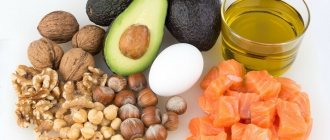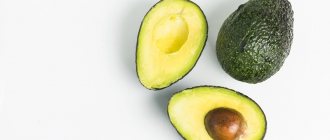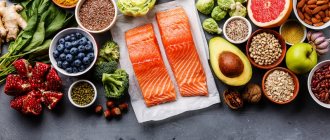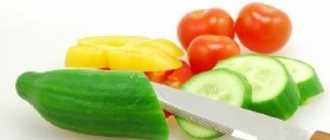July 17, 2012
Traditionally, fats are considered an unhealthy food. Let's look at why the term "good" fats is not an oxymoron.
Traditionally, fats are considered an unhealthy food. They are usually blamed for almost all diseases, from cardiovascular diseases to diabetes. However, there are different types of fats: good, bad and very bad. All of them have different effects on human health. Let's look at why the term "good" fats is not an oxymoron.
Deceiving food
There is also fat in doctor's sausage, but due to the fine grinding of the minced meat it is difficult to notice. Learn more about where to look for hidden fat and added sugar.
Good fats: unsaturated
Unsaturated fats are divided into mono- and polyunsaturated. Both of these types lower
blood cholesterol levels. Thus, they fight diseases caused by excess fat in the diet.
Monounsaturated fats are considered the healthiest
.
They reduce the level of “bad” cholesterol, which accumulates in blood vessels and clogs them. In addition, monounsaturated fats increase the level of “good” cholesterol, which cleanses blood vessels. Polyunsaturated fats
are an excellent source of
Omega-3
.
The human body is not capable of producing them, so you can only get Omega-3 fatty acids from food
.
They are rich in fatty sea fish, nuts, seeds and oils. They are also found in dark green leafy vegetables, flaxseed oil and other unrefined oils. These acids not only reduce the content of “bad” cholesterol in the blood, but also normalize blood pressure, fight inflammation and protect the brain from neurodegenerative changes.
Are there fats that help you lose weight?
This is a double-edged sword. Fats contain 9 calories per gram, more than twice the calories of proteins and carbohydrates.3 Fats are high in calories, so some people can easily gain extra calories. If you want to lose weight, you need to be in a calorie deficit (that is, consume fewer calories than your body burns). Eating too much fat can put you in a calorie surplus.
There is no fat that will help you lose weight. But there are still some fats that can help the body break down stored fat and use it as fuel. Against the backdrop of a calorie deficit, consuming such fats can make the weight loss process a little more effective.
- Omega-3 Fish Oil
There is some research suggesting that a diet high in omega-3s may have some effect on weight loss in overweight people. However, the researchers stipulate that to obtain this effect, omega-3 intake must be combined with diet and exercise. The results of the studies were modest at best, but there was some slight weight loss among the subjects. In addition, omega-3 acids are very healthy and have a number of additional benefits, so including them in your diet can be a good idea.10
- MCTs or medium chain triglycerides
MCT is a medium-chain triacylglycerol that is digested differently than other fats. Medium chain triglyceride oil is broken down and metabolized in the liver and is not stored as easily as other fats. MCT, used along with a calorie deficit and exercise, can be a good strategy for weight loss. Just like with omega-3, the results are quite modest, but this oil can also help you lose some weight.6
Don't "good" fats make you fat?
All vegetable oils are a combination of polyunsaturated and monounsaturated fatty acids in varying proportions.
Olive oil is the richest in monounsaturated fatty acids. However, do not forget that any fat in terms of caloric content remains ordinary fat. Therefore, labels on vegetable oil bottles that advertise the product as “light” imply its purity or taste, not its reduced fat content.
All vegetable oils
are 100 percent fat
.
This means that a tablespoon of the product contains about 120 kcal. Such a spoon on a large salad bowl will make the dish even healthier. While vegetables drowned even in extra virgin olive oil will be higher in calories and more useless than dessert.
A balanced diet is the key to good health
A healthy lifestyle includes adequate physical activity, whole foods as the basis of the diet, moderate portion sizes and a variety of foods. The Mediterranean diet, based on the consumption of fruits, vegetables, whole grains, fish and foods made with vegetables and vegetable oils, is associated with a lower risk of heart attacks and cardiovascular disease. Diets rich in whole foods are often more effective in preventing cardiovascular disease than restrictive diets low in fat and cholesterol.
What do you think of the latest evidence on saturated fat? We'd love to hear what you think about it... The comment form is below.
Bad fats: saturated
Saturated fats are found in animal products - mainly meat and milk. They remain solid at room temperature.
Scientists rightly blame this type of fat for increasing the level of “bad” cholesterol in the blood. Therefore, experts recommend replacing some of these fats with unsaturated ones. Important: you don't need to completely give up saturated fats
.
They contain vitamins. And stearic acid is even capable of being converted in the body into oleic acid, a monounsaturated fatty acid. Nutritionists recommend excluding from your diet only fatty pork and processed meat products that contain large amounts of hidden fat: sausages, sausages, and processed foods. Choose fresh meat and poultry, trim off excess fat and do not use oil when cooking them.
Issues with eating fats
| How much fat should you eat per day? |
Fats contain the greatest amount of energy compared to other macronutrients - 9 kcal/g. The amount of fat that should come from food depends on many factors: your age, health status, amount of physical and mental activity, climatic conditions of your residence.
| Experts from different countries in the field of nutrition have established that a person needs to receive no more than 20-35% (WHO indicates <30%) of daily total energy from fats. |
In this case, the norms for adults:
- saturated fatty acids – no more than 10% (no more than 1/3 of the total fat);
- monounsaturated fatty acids – 10% (1/3 of the total fat);
- polyunsaturated fatty acids – 6-10% (≤1/3 of the total amount of fat), of which 5-8% of the daily caloric intake for Omega-6 and 1-2% for Omega-3.
The WHO fact sheet (September 2015) states that reducing total fat intake to less than 30% of total energy helps prevent unhealthy weight gain among adults .
The risk of developing non-communicable diseases is reduced by reducing saturated fats to less than 10% of total energy, and trans fats to less than 1% of total energy and replacing them with unsaturated fats, which are found in vegetable oil.
It is important not to allow either a deficiency or excess of fat in the diet.
Fat deficiency:
- worsens the condition of the skin (dryness and pustular diseases appear), hair;
- delays the growth and development of a growing organism;
- disrupts reproductive function in women (amenorrhea may occur);
- disrupts cholesterol metabolism;
- negatively affects the functioning of the nervous system and brain, leading to symptoms of depression;
- leads to a deficiency of vitamins that are soluble only in fats.
Excess fat:
- leads to obesity (hence, mobility decreases, appearance deteriorates, the cardiovascular system malfunctions, blood composition deteriorates, the risk of stroke, atherosclerosis, coronary heart disease, hypertension and other diseases increases);
- causes a threat of damage to the liver, pancreas, development of cancer, cholelithiasis.
| What should I do if I have high cholesterol? |
First of all, you need to find out which cholesterol (“good” or “bad”) is responsible for the increased level of total cholesterol. If the proportion of “good” cholesterol is increased, high total cholesterol is not really a warning factor.
If your LDL cholesterol level increases, you should consult your doctor!
| General recommendations: To reduce “bad” cholesterol, it is better to supplement a balanced diet with physical activity, maintain a healthy weight, reduce stress and not smoke. |
It is not recommended to completely abandon the consumption of animal fats and replace them with vegetable fats (although advice on replacing fats can often be heard from nutritionists).
To date, scientific data on the effect of saturated fats on the development of cardiovascular diseases and mortality from them are contradictory. It has been established that vegetable fats reduce the level of “bad” cholesterol (LDL), but at the same time they often reduce the level of “good” cholesterol (HDL) , which is exactly the situation that can increase mortality from diseases of the cardiovascular system.
Foods high in soluble fiber (fruits, vegetables, oats, legumes) can help lower bad cholesterol levels in the blood. Foods rich in soy protein (tofu, soybeans, soy milk) may also help reduce cholesterol levels slightly.
| Is it true that adding vegetable oil to foods helps absorb vitamins from them? |
Yes, there are a number of vitamins (A, D, E, K) that are fat soluble. They enter the body from food and are stored in fatty tissues. For example, carrots (a source of provitamin A - beta-carotene) are best eaten with butter or sour cream. Salads containing green leafy vegetables and cabbage (a source of vitamin K) are also seasoned with oil.
| If I do decide that I want a fried dish, what oil is best to cook it in? |
When choosing an oil for frying, an important characteristic is its smoke point (the temperature at which the oil begins to break down and become unsuitable for food). Visually, the oil begins to smoke. Refining oils increases their smoke point.
Frying of the product occurs at a temperature of more than 100 degrees, the formation of a golden crust occurs at 140-165 degrees. Thus, it is preferable to fry in oil that has a smoke point of 160 degrees or higher.
It is better to pour oil into a cold frying pan, and when it heats up, immediately start frying.
We offer for consideration a table reflecting the characteristics of the most preferred fats and oils for frying:
| Oils | Lipid composition, % | Recommended Application | Useful Features | ||
| Monounsaturated | Polyunsaturated | Saturated | |||
| Coconut oil | 6 | 2 | 92 | Browning meat, searing, deep frying | No cholesterol |
| Palm kernel oil | 12 | 2 | 86 | Browning meat, searing, deep frying | No cholesterol. Stores well at room temperature. Rich in vitamin K. |
| Butter | 28 | 4 | 68 | Best for baking, roasting or stewing. For frying at high temperatures, it is recommended to use ghee or ghee. | Contains vitamins A, E, K2. Rich in conjugated linoleic acid (CLA) fatty acids and butyrates. CLA can reduce body fat in humans, butyrates are involved in fighting inflammation, helping reduce obesity and stimulating bowel function. |
| Ghee oil | 30 | 5 | 65 | Browning meat, searing, deep frying | Stores well at room temperature. High smoke point - about 500⁰. During the production process, the amount of lactose and casein is reduced to a minimum, so this oil is suitable for people intolerant. Rich in vitamins A, D, E, and K. |
| Palm oil | 38 | 10 | 52 | Browning meat, searing, deep frying | Red palm oil (unrefined) is better. It is rich in vitamin E, coenzyme Q10 and other beneficial substances |
| Animal fats – lard, beef, chicken fat, bacon | 44-47 | 4-22 | 31-52 | Light roasting, stewing | The composition and beneficial properties vary greatly depending on the species and food supply. |
| Olive oil | 78 | 8 | 14 | Stewing, frying at low temperatures (peeled). Dressing and adding to prepared dishes (extra virgin) | The higher the degree of purification, the higher the smoke point. Oil with the highest content of monounsaturated fatty acids. Increases HDL levels. Activates the secretion of bile and pancreatic hormones. |
| Canola (rapeseed oil) | 62 | 31 | 7 | Stewing, frying at low temperatures | High levels of monounsaturated fats increase HDL levels. Contains small amounts of Omega-3 |
| Avocado oil | 73 | 19 | 18 | Roasting at high temperatures, browning meat | Due to the high content of polyunsaturated fats, it is not recommended for everyday use. Contains vitamin E. |
| Nut butters (peanut, almond, hazelnut, macadamia) | 48-84 | 3-34 | 7-18 | Dressing, adding to prepared dishes. Not recommended for frying | They have unique taste characteristics, but most are rich in polyunsaturated fats, which makes them unsuitable for everyday use. The exception is macadamia oil. |
| Flaxseed, hemp, sesame, unrefined sunflower oil, wheat germ oil, cottonseed oil | — | — | — | Not suitable for heating. May have limited use in some dishes. For food purposes, cottonseed oil must be refined, because unrefined oil contains a toxic substance - gossypol. | You must read the label carefully - it may contain trans fats! |
| How to store and use oils? |
Let's look at the example of butter, olive and flaxseed oils.
good butter should have a dense, uniform consistency with a slightly shiny or slightly matte surface, a shiny cut, and a uniform color from light yellow to yellow. A slightly crumbly consistency or the presence of tiny single droplets of moisture is acceptable.
Unused butter is stored in the refrigerator away from strong-smelling foods at a relative humidity of no more than 90% for 10 to 30 days, depending on the type of packaging (for example, butter is stored better in foil than in parchment). However, if you purchased too much butter, know that its shelf life at a storage temperature not exceeding minus 25°C ranges from 6 to 24 months.
Like many other vegetable oils, olive oil in small quantities, in dark glass bottles.
The beneficial properties of olive oil are preserved for 5-12 months from the date of production; over time, it deteriorates and expires, and acidity increases. After opening, it should be stored hermetically sealed, in a dark, dry, cool place, protected from strong odors, preferably consumed within a month.
In the cold (for example, in the refrigerator), it may become cloudy and produce a small sediment - if there is no sudden separation of the liquid, everything is in order. After heating to room temperature, the sediment should disappear, and the oil should return to transparency, but the oil may lose its taste.
Flaxseed oil is more prone to oxidation compared to olive oil, so you should monitor its storage conditions even more carefully. The oil should also be stored in a light-protected glass container with a tightly closed neck (lid). The smaller the volume of the purchased portion, the better; after opening, the oil can be stored for no more than 30 days in a cool, dark place (at a temperature no higher than +10 degrees). Be sure to pay attention to its expiration date (no more than 6 months from the date of spinning).
Authors: Elena Degtyar, PhD, head of the scientific department of the #SEKTA School, Anastasia Kokoulina, employee of the scientific department of the #SEKTA School, Maria Kardakova, MSc, Alexandra Romek, MSc
References: 1. Popkin, BM (2012) Global nutrition transition and the pandemic of obesity in developing countries. Nutrition reviews 70 (1): pp. 3 -21. Access date: 11/06/2016 – 01/30/2017 2. All about cholesterol: national report; edited by Academician of the Russian Academy of Medical Sciences L. A. Bockeria, Academician of the Russian Academy of Medical Sciences R. G. Oganov. – M.:NTsSSKh them. A. N. Bakuleva RAMS, 2010. – 180 p. Access date: 11/06/2016 - 01/30/2017 3. Understanding Cholesterol - Dr. Fiona Dulbecco, MD. Date of access: 11/06/2016 - 01/30/2017 4. Simopoulos AP Essential fatty acids in health and chronic disease //The American Journal of Clinical Nutrition. – 1999. – T. 70. – No. 3. – pp. 560s-569s. Date accessed: 11/06/2016 - 01/30/2017 5. Torpy, J. M., C. Lynm, and R. M. Glass. 2006. Eating fish: Health benefits and risks. JAMA 296:1926. Date accessed: 11/06/2016 - 01/30/2017 6. McNamara, R. K., and S. E. Carlson. 2006. Role of omega-3 fatty acids in brain development and function: Potential implications for the pathogenesis and prevention of psychopathology. Prostaglandins Leukot Essent Fatty Acids 75:329–49. Access date: 11/06/2016 – 01/30/2017 7. St-Pierre AC et al. Low-density lipoprotein subfractions and the long-term risk of ischemic heart disease in men 13-year follow-up data from the Québec Cardiovascular Study //Arteriosclerosis, thrombosis, and vascular biology. – 2005. – T. 25. – No. 3. – pp. 553-559. Access date: 11/06/2016 – 01/30/2017 8. Campos H. et al. Low density lipoprotein particle size and coronary artery disease //Arteriosclerosis, thrombosis, and vascular biology. – 1992. – T. 12. – No. 2. – pp. 187-195. Date of access: 11/06/2016 - 01/30/2017 9. Gardner CD, Fortmann SP, Krauss RM Association of small low-density lipoprotein particles with the incidence of coronary artery disease in men and women //Jama. – 1996. – T. 276. – No. 11. – pp. 875-881. Access date: 11/06/2016 – 01/30/2017 10. Greene CM et al. Maintenance of the LDL cholesterol: HDL cholesterol ratio in an elderly population given a dietary cholesterol challenge //The Journal of nutrition. – 2005. – T. 135. – No. 12. – pp. 2793-2798. Date of access: 06.11.2016 - 30.01.2017 11. Fernandez ML Dietary cholesterol provided by eggs and plasma lipoproteins in healthy populations //Current Opinion in Clinical Nutrition & Metabolic Care. – 2006. – T. 9. – No. 1. – pp. 8-12. Access date: 11/06/2016 — 01/30/2017 12. Eyres L, Sherpa N and Hendriks G: Avocado oil: a new edible oil from Australasia. Lipid Technol 2001;Vol 13, no 4:84-88. Date of access: 06.11.2016 - 30.01.2017 13. Norms of physiological needs for energy and nutrients for various groups of the population of the Russian Federation Methodological recommendations MR 2.3.1.2432 -08. Access date: 11/06/2016 – 01/30/2017 14. Ask the Expert: Healthy Fats // Harvard TH Chan. School of Public Health. Date of access: 06.11.2016 - 30.01.2017 15. Cardiovascular Disease and Milk Products: Summary of Evidence/Dairy nutrition Dedicated to Health Professionals Date of access: 06.11.2016 - 30.01.2017 16. Fats and oils in human nutrition. Report of a joint expert consultation. – FAO 1994. Date of access: 11/06/2016 - 01/30/2017 17. Robert L. Wolff. Heat-induced geometrical isomerization of α-linolenic acid: Effect of temperature and heating time on the appearance of individual isomers [Electronic resource]// Journal of the American Oil Chemists' Society. April 1993, Volume 70, Issue 4, pp 425–430 Date of access: 11/06/2016 - 01/30/2017 18. Fats and Cholesterol // Harvard TH Chan. School of Public Health. Date of access: 06.11.2016 - 30.01.2017 19. Przybylski O, Aladedunye FA. Formation of trans fats during food preparation. [Electronic resource]// Can J Diet Pract Res. 2012 Summer;73(2):98-101. Date of access: 11/06/2016 - 01/30/2017 20. Wakako Tsuzuki, Akiko Matsuoka, Kaori Ushida. Formation of trans fatty acids in edible oils during the frying and heating process [Electronic resource] //Food Chemistry.2010; vol. 123 issue 4: 976-982 DOI: 10.1016/j.foodchem.2010.05.048 Access date: 11/06/2016 — 01/30/2017 21. Frying Q&A. Trans Fat Help Date of access: 11/06/2016 - 01/30/2017 22. Jonathan Belsey et. al. Abnormal lipids in high-risk patients achieving cholesterol targets: a cross-sectional study of routinely collected UK general practice data [Electronic resource]// Current Medical Research and Opinion. Volume 24, 2008 - Issue 9. Date of access: 11/06/2016 - 01/30/2017 23. Patty W Siri-Tarino et. al. Meta-analysis of prospective cohort studies evaluating the association of saturated fat with cardiovascular disease [Electronic resource]// Am J Clin Nutr.2010. doi: 10.3945/ajcn.2009.27725 Date of access: 11/06/2016 - 01/30/2017 24. Healthy eating. WHO Information Bulletin N°394. September 2015 Date of access: 11/06/2016 - 01/30/2017 25. Benjamin Wedro. Cholesterol Management /MedicineNet.com Date updated: 27/10/2015 Date accessed: 11/06/2016 - 01/30/2017 26. 2015–2020 Dietary Guidelines for Americans Date accessed: 11/06/2016 - 01/30/2017 27. Dietary Guidelines for Americans, 2010 Date appeals: 06.11.2016 - 30.01.2017 28. R Uauy et. al. WHO Scientific Update on trans fatty acids: summary and conclusions [Electronic resource] //European Journal of Clinical Nutrition (2009) 63, S68–S75. doi:10.1038/ejcn.2009.15 Date of access: 11/06/2016 - 01/30/2017 29. Siri-Tarino PW et. al. Saturated fat, carbohydrate, and cardiovascular disease. [Electronic resource] // Am J Clin Nutr. 2010 Mar;91(3):502-9. doi: 10.3945/ajcn.2008.26285. Date of access: 06.11.2016 - 30.01.2017 30. Dias CB et. al. Saturated fat consumption may not be the main cause of increased blood lipid levels. [Electronic resource]//Med Hypotheses. 2014 Feb;82(2):187-95. doi: 10.1016/j.mehy.2013.11.036. Date of access: 11/06/2016 - 01/30/2017 31. Mu Chen et.al. Dairy fat and risk of cardiovascular disease in 3 cohorts of US adults [Electronic resource] // Am J Clin, 2021. doi: 10.3945/ Date of access: 11/06/2016 - 01/30/2017
Worst Fats: Trans Fats
Trans fats are also known by another name - hydrogenated fats
.
They are obtained through a hydrogenation process that converts liquid vegetable oils into solid fats. This allows you to replace butter or pure animal fat with cheaper alternatives
. Scientists believe that trans fats are much more harmful than saturated fats. Because they not only increase the level of “bad” cholesterol, but also reduce the content of “good” cholesterol. Trans fats can be hidden in all types of processed foods, from French fries to regular cookies. This is not surprising: they are cheaper, store and transport better, and behave more predictably during the cooking process than their animal counterparts.
20 facts about healthy eating
Fats make up the membranes of nerve fibers, they are part of the structure of the cell wall, and are also necessary for cell division and the synthesis of important hormones. You can’t completely eliminate fats – that’s a fact.
A little about trans fats
Trans fatty acids (or trans fats) are obtained by hydrogenating vegetable oils. It is a chemical process that aims to convert liquid oils into solids for their widespread use as an ingredient in frying and baking. Hydrogenated oils are used in food processing to increase the shelf life, flavor and cooking properties of processed foods such as cookies, cakes, pies and fast food. Small amounts of naturally occurring trans fats are present in dairy products such as cheese, sour cream and cream, as well as beef and lamb.
Recently, a healthy lifestyle has become increasingly popular and information about the negative health consequences of consuming large amounts of trans fats has become widespread. Thanks to this, in recent years, more and more manufacturers are choosing to use natural, healthy ingredients in food production, which indicates significant progress in the field of health, but there is still a long way to go before a complete ban on harmful ingredients. Read more about trans fats on this page - What are trans fats and why are they dangerous.
How to make friends with fats?
The human body needs fats. They are a source of energy, a necessary substance for the normal functioning of cells, the nervous system, and a prerequisite for the absorption of certain vitamins. In addition, fats help maintain healthy hair and skin and even protect the body from cold. However, experts recommend limiting your fat intake to 30 to 35 percent
of your daily calorie intake. These values should not fall below 20 percent. In addition, most of the fats should be unsaturated – that is, liquid oils. It is better to minimize the fat content of dairy products by avoiding regular consumption of too fatty and salty hard cheeses. In addition, nutritionists recommend eating no more than one serving of meat or poultry the size of a playing card per day. But you shouldn’t limit yourself when it comes to fish consumption. A healthy diet should include at least two servings of fish per week. It’s better to say goodbye to fast food and other processed foods altogether – food at home turns out no worse.
Description and benefits of omega-3
Omega-3 polyunsaturated fatty acids
- organic compounds, in the structure of which, in addition to single (in other words, “saturated”) bonds, there are also double bonds between carbon atoms. The most famous representatives of this class - eicosapentaenoic acid (EPA) and docosahexaenoic acid (DHA) - can be formed during the transformation of essential alpha-linolenic acid - due to the body’s inability to synthesize it, it must be supplied with food or in the form of dietary supplements.
- Omega-3 and the nervous system
Remarkable and very important from the point of view of growth and normal development is the fact that DHA predominates in the gray matter of the brain. Despite the fact that this acid is also contained in breast milk, the baby’s needs for it (especially in the first months of life) are very high.
Considering that during the last trimester, the formation of omega-3 reserves is very active - these polyunsaturated acids, penetrating the placental barrier, regulating and selectively (as when issuing a visa) passing certain molecules through the blood from the mother to the child and vice versa, have a powerful stimulating effect. influence on the formation of the Central nervous system. That is why for prematurely born children it is recommended to consider additional intake of essential omega-3 PUFAs.
In addition, after birth, these compounds continue to exhibit multiple effects across a very broad spectrum. So, for example, in the course of a study, British scientists discovered the positive effect of omega-3 in the treatment of ADHD (attention deficit hyperactivity disorder) - at least 40% of children had a higher concentration and concentration, and young schoolchildren significantly improved their abilities to reading and writing.
- Omega-3 and vision
Docosahexaenoic acid occupies a leading position among phospholipids in the cell membranes of retinal photoreceptors. In addition, DHA is also involved in the process of regeneration of visual pigment (that is, its restoration).
In addition, polyunsaturated fatty acids in the retina have a protective effect, protecting its delicate structure from reactive oxygen species, inflammatory mediators and various signaling molecules involved in inflammatory processes.
Study
: Long-chain polyunsaturated fatty acids of the omega-3 family in the prevention of diseases in adults and children: the view of a clinical pharmacologist
- Omega-3 and the cardiovascular system
Numerous studies by scientists show that taking omega-3 PUFAs is associated with a reduced risk of heart pathologies. In particular, this is achieved by reducing the level of triglycerides (due to increased oxidation of fatty acids included in their composition in the liver, as well as inhibition of lipogenesis in general) and increasing the concentration of high-density lipoproteins (HDL - anti-atherogenic), as well as by inhibiting aggregation platelets (that is, their connection with each other and the subsequent formation of a “plug” at the site of damage).
The American Heart Association emphasizes that taking 4 grams per day of prescription medications containing omega-3 PUFAs reduces high triglyceride levels. However, doctors emphasize: first of all, it is necessary to exclude other causes of their increase: such as hypothyroidism and/or type 2 diabetes.
Study
: Prescription omega-3 fatty acid medications effectively lower high triglycerides
In addition, taking DHA (4 g/day) was accompanied by a decrease in blood pressure - thus, scientists came to the conclusion that omega-3 fatty acids can also affect the endothelium (inner lining) of blood vessels.
In addition, omega-3 fatty acids, when included in the phospholipid layer of cell membranes, are able to change their fluidity, as well as control the transmission of signals through them.
These organic compounds, by regulating the function of membrane channels (sodium and calcium), prevent the development of lethal arrhythmias.
Omega-3 PUFAs can, instead of arachidonic acid (omega-6 PUFAs), act as a substrate (raw material) for the action of an enzyme such as cyclooxygenase. As a result, much weaker reaction products are formed instead of pro-inflammatory molecules.
Study
: Cardioprotective mechanism of omega-3 polyunsaturated fatty acids
- Omega-3 and skeletal muscle
Studies note that consuming omega-3 PUFAs prevents the breakdown of muscle proteins, a function associated specifically with the action of EPA.
Thus, supplementing the diet of 45 exercise volunteers with 2 grams of omega-3 for 90 days was associated with significant improvements in muscle fiber strength and neuromuscular transmission. It is believed that these results are achieved by increasing the sensitivity of muscle tissue to a neurotransmitter such as acetylcholine, which takes part in the synapse and thereby stimulates muscle contraction.
In addition, some data indicate the ability of omega-3 to activate the formation of new mitochondria due to increased expression of certain mitochondrial factors and proteins.
Considering that skeletal muscles are insulin-dependent tissues (that is, through the action of this hormone, glucose from the blood enters their cells), any dysfunction in the implementation and regulation of this process leads to insulin resistance - a key stage in the path of type 2 diabetes. With the development of this pathology, there is a decrease in the absorption of glucose by muscles, a decrease in the synthesis of glycogen (acting as a reserve reserve of carbohydrates), a violation of the oxidation of fatty acids and, accordingly, an increase in their pool.
Rodents fed a high-fat diet but supplemented with fish oil had less impaired glucose tolerance than those fed a high-fat diet. In addition, they, although to a lesser extent than the control group of rodents on a normal, balanced diet, showed a decrease in intracellular lipids and some types of ceramides (markers of lipid-induced insulin resistance).
Study
: Omega-3 Fatty Acids and Skeletal Muscle Health
What should be included in the menu
Unsaturated fats belong to the group of easily digestible substances. But you should not abuse food rich in these substances, unique in their composition.
To speed up the absorption process, eat foods that have not been heat-treated. The breakdown of these substances and the rate of absorption into the blood are influenced by the melting temperature. The higher it is, the worse the element is absorbed.
Unsaturated fatty acids are involved in the formation of the human immune system, brain function, and heart function. They improve memory, attention and help fight depression. Without fats, the body poorly absorbs vitamins A, D, K, E. Eat healthy fats daily; the list of products presented in the table below will allow you to develop a complete and balanced menu for every day.











